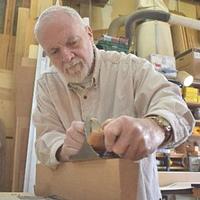Kelly
in over 11 years
Grizzly G0490X 8" Jointer with Spiral Head Review
GRIZZLY G0490X 8" JOINTER
After a year of looking for a good jointer and losing out on three nice ones, due to procrastination, I finally bit the bullet and bought a new Grizzly 8" Jointer with the helix head.
The model number is G0490X. The X indicates the jointer is equipped with a helix head.
Assembled, the jointer is the heaviest tool in my little shop, weighing about five hundred seventy-five pounds.
Now that I’ve ran some highly figured walnut through the Grizzly, I’m glad I missed the boat on the other jointers, which were equipped with knives.
ASSEMBLY-OPERATION MANUAL
Generally, the manual is good and lets you know all you need to know to get your jointer up and going. More information could have been provided on installing the guard, but little else is left to the imagination, or others’ experiences.
ASSEMBLY
I drove from North Central (Eastern) Washington to Bellingham and picked the jointer up at that Grizzly showroom. Though quite distant, it’s an impressive place and one I wish I could visit more often.
Loading the two boxes into my little Ford Ranger allowed me to appreciate the size and weight of the jointer. Subsequently, and during the trip back, I was concerned about getting the jointer out of my truck and assembled. Moving it from the garage into the shop, on the other hand, didn’t worry me, because the unit is equipped with wheels (the single one is iron).
I had seen a few guys rig harnesses and lift the bed onto the stand. As fate would have it, though working with a large piece of missing heart and at sixty-four, I was able to do remove the unit from my truck and assemble it by myself with less significantly less effort than I used to move my Unisaw.
I was able to ease the base, with the motor, out of the truck by flipping it and easing it down and out. Turning the box upside down is not a problem, since the motor is secured and you have to, if you want to life the box off the base.
Once the base was on the floor, I removed the side panels and installed the wheels, then turned the unit right side up again. Then I installed the motor, but didn’t tighten the bolts, so I could adjust it later.
NOTE: The control panel mounts on the jointer, once on the base.
After the base was mobile, I removed all but the base of jointer crate. Then, I was able to push down on the jointer bed and duck walk it off its crate base. Apparently, I was lucky, it was not bolted to the base (and was undamaged).
After I removed the crating top, sides, front and back, I rolled the base to the back of the pickup and locked the wheels. For my pickup, there was only about 1/2" difference in height between the truck bed and the mobile base.
I was able to pull the jointer straight back and out of the pickup with surprisingly little effort. Before easing it onto the base, I put some of the crate foam under the front of the jointer, to avoid scratching the base as I pulled the jointer fully on to the base.
Once the jointer was ready to drop off the truck, I put more foam under that end, then finished pulling the jointer out of the truck, onto the jointer. It landed on the jointer smoothly.
If there had been more of a height difference, merely placing 2x’s, boards or whatever was needed to fill the gap would have allowed me perform these tasks will only a little more effort, but not a lot of brawn.
Once the jointer was on the base, I lifted the ends, one at a time, and removed the foam.
The wheel raising and lowering mechanism works like a charm. I moved the base and jointer back from the truck, bolted the jointer to the base, then bolted the control panel to the jointer.
With comfortable working room, I just used one of my depth gauges to insure the motor pulley was the same distance from the back side of the base as the pulley of the jointer and went through the expected steps to lock it in position, and lock down the motor. Cake walk.
I did a quick install of the fence and guard, then re-installed the sides and rolled the unit into its place in the shop. It rolled nice, but was a little like herding a slightly trained cat.
Once in the shop, I had to loosen the top screw of the guard and turn the part it was holding with channel locks to add tension necessary to its working properly. This was not covered in the, otherwise, good manual.
The stock plug was the same as my cabinet saw, so testing the jointer was a plug swap away.
SET UP
I was able to get good edge joints on two inch thick stock running the jointer out of the box.
I had to tweak the eccentric bed adjustments to produce six inch stock that could be glued face to face.
I was apprehensive about how complicated it would be to adjust the eccentrics, but it went quickly. It was a simple matter of loosening the Allen screws and using a drift punch to coax minor movement, then seeing if I had more or less air under the straight edge.
I adjursted the stops with relative ease, per the diretion
OPERATION
Setting the in-feed table height is just a matter of turning the table lock, then moving the lever under it. I tapped it to get it to move the little I wanted for the setting I was after.
The gauge is a reasonable indicator of the depth of cut. If I need dead on precision, I’ll take the faced wood to the planer.
The power button is mounted on a steel tube and feels stout, when turning the unit on or off.
Had I not read the manual, it might have taken a moment to figure out the OFF button has to be turned, before the ON (start) button will start the motor. The red light indicates the unit is off and the knob needs to be turned to turn the jointer on.
The three horse motor on this unit starts harder than the one on my Unisaw. However, after the initial start, the jointer felt smooth and the running motor has that nice sound of a power you expect with a cabinet saw.
Using several passes, at about 1/16" per pass, I converted some very rough and highly figured walnut into boards that will require only a little finish sanding. They were were good enough to face joint, so edge jointing would have been a cake walk.
Of course, the spiral head inserts were all new, but I could not see any tear out, even around the tight knot in the most figured area.
Having only used planers with knives up until now, it’s comforting to know blade changes will be fewer, because of the carbide edges on the spiral head. Too, it’s comforting to know I don’t have to change all the blades because of a nick. I just have to turn the damaged insert(s) ninety degrees.
DUST COLLECTION
For the time being, the Grizzly is connected to my 3hp Jet collector via twenty feet of 4" hose. In spite of that, I leave more shavings on the floor sharpening a carpenter’s pencil.
4 Replies
I am without a doubt jealous now. That macho e sou day incredible.
Jamesw
Sounds incredible.
Jamesw
Always nice to get new equipment .
Wheaties
Boy does that bring back memories of when I head to uncrate and assemble my 1000 lb 12" jointer by myself.I know you will really enjoy the helix head ,they work great.
woodworking classes, custom furniture maker











